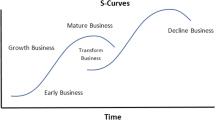Abstract
This research analyzes the performance of 467 record labels in eight European countries over a period of 13 years (2003–2015). The main goal is to explain a relative measure of profitability in terms of observed variables, although the nature of the dataset also allows us to include non-observed firm and country effects. To this end alternative models are estimated and three main research questions are tested, namely: (1) the effect of the dual structure of the recorded music market, in which a competitive segment and an oligopoly coexist; (2) the extent and source of the volatility of profits in record labels; and (3) the nonlinear impact of size on performance.


Similar content being viewed by others
Notes
While major labels usually retain the copyright on the sound recording of an act, independent labels do not.
See SGAE (2012).
Given the time span of the sample, we still include EMI as a separate firm.
One needs to assume strong exogeneity, and error terms and random effects at both levels being iid. Let X be the set of explanatory variables. Then:
$$\begin{aligned}&E[\epsilon _{ijt}|U_{0ij},U_{0j},X]=0 \\&\quad \epsilon _{ijt}\sim [0,\sigma _\epsilon ^2] \\&\quad U_{0ij}|X,u_{0i}\sim [0,\phi ^2] \\&\quad U_{0j}|X\sim [0,\psi ^2] \end{aligned}$$An anonymous referee suggested us to test for this increasingly negative effect. In so doing, we estimated the model for two subsamples: before and after 2008 (first introduction of Spotify, a music streaming service, in main European markets). The negative effect of the ratio of fixed assets over total assets is larger (and its significance greater) in the second sample, although the large standard error of the pre-2008 estimation yields wide confidence intervals.
However, there was some ambiguity as to the preferred model based on information criteria, as BIC and AIC led to contradictory results.
E.g. ownership of sound recordings is considered an asset, a practice that is not that common for smaller independent firms.
References
Baker, A. J. (1991). A model of competition and monopoly in the record industry. Journal of Cultural Economics, 15(1), 29–53.
Bou, J. C., & Satorra, A. (2007). The persistence of abnormal returns at industry and firm levels: Evidence from spain. Strategic Management Journal, 28(7), 707–722.
Bourreau, M., Gensollen, M., & Moreau, F. (2012). The impact of a radical innovation on business models: Incremental adjustments or big bang? Industry and Innovation, 19(5), 415–435.
Bourreau, M., Gensollen, M., Moreau, F., & Waelbroeck, P. (2013). Selling less of more? The impact of digitization on record companies. Journal of Cultural Economics, 37(3), 327–346.
Burke, A. E. (1996). The dynamics of product differentiation in the British record industry. Journal of Cultural Economics, 20(2), 145–164.
Cameron, S. (2016). Past, present and future: Music economics at the crossroads. Journal of Cultural Economics, 40(1), 1–12.
Dowd, T. J. (2004). Concentration and diversity revisited: Production logics and the us mainstream recording market, 1940–1990. Social Forces, 82(4), 1411–1455.
Gander, J., & Rieple, A. (2004). How relevant is transaction cost economics to inter-firm relationships in the music industry? Journal of Cultural Economics, 28(1), 57–79.
Goddard, J., Tavakoli, M., & Wilson, J. O. (2005). Determinants of profitability in European manufacturing and services: Evidence from a dynamic panel model. Applied Financial Economics, 15(18), 1269–1282.
Goddard, J., Tavakoli, M., & Wilson, J. O. (2009). Sources of variation in firm profitability and growth. Journal of Business Research, 62(4), 495–508.
Hendricks, K., & Sorensen, A. (2009). Information and the skewness of music sales. Journal of Political Economy, 117(2), 324–369.
Hesmondhalgh, D. (1998). The British dance music industry: A case study of independent cultural production. British Journal of Sociology, 49, 234–251.
Hirsch, P. M. (1972). Processing fads and fashions: An organization-set analysis of cultural industry systems. American Journal of Sociology, 77, 639–659.
Lopes, P. D. (1992). Innovation and diversity in the popular music industry, 1969 to 1990. American Sociological Review, 57, 56–71.
McGahan, A. M. (1999). The performance of us corporations: 1981–1994. Journal of Industrial Economics, 47, 373–398.
McGahan, A. M., & Porter, M. E. (1999). The persistence of shocks to profitability. Review of Economics and Statistics, 81(1), 143–153.
Ordanini, A. (2006). Selection models in the music industry: How a prior independent experience may affect chart success. Journal of Cultural Economics, 30(3), 183–200.
Peterson, R. A., & Berger, D. G. (1975). Cycles in symbol production: The case of popular music. American Sociological Review, 40, 158–173.
Power, D., & Hallencreutz, D. (2002). Profiting from creativity? The music industry in Stockholm, Sweden and Kingston, Jamaica. Environment and Planning A, 34(10), 1833–1854.
Scott, A. J. (1999). The US recorded music industry: On the relations between organization, location, and creativity in the cultural economy. Environment and Planning A, 31(11), 1965–1984.
SGAE. (2012). Anuario SGAE de las artes escénicas, musicales y audiovisuales (Performing arts, music and audiovisual yearbook). Fundacin Autor. http://www.anuariossgae.com/.
Strachan, R. (2007). Micro-independent record labels in the uk discourse, diy cultural production and the music industry. European Journal of Cultural Studies, 10(2), 245–265.
Tschmuck, P. (2012). Creativity and innovation in the music industry. Berlin: Springer.
Acknowledgements
The authors would like to thank two anonymous referees for their helpful suggestions. Juan D. Montoro-Pons would also like to thank Peter Tschmuck and participants at the 5th Vienna Music Business Research Days for comments and discussion on a preliminary version of the paper. Usual disclaimer applies.
Author information
Authors and Affiliations
Corresponding author
Rights and permissions
About this article
Cite this article
Montoro-Pons, J.D., Cuadrado-García, M. “Let’s make lots of money”: the determinants of performance in the recorded music sector. J Cult Econ 42, 287–307 (2018). https://doi.org/10.1007/s10824-017-9304-2
Received:
Accepted:
Published:
Issue Date:
DOI: https://doi.org/10.1007/s10824-017-9304-2




